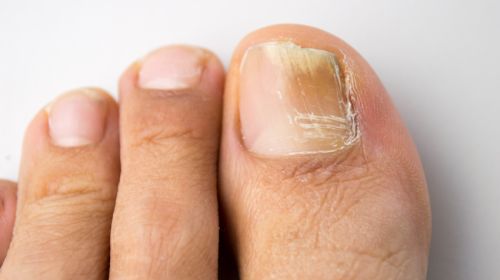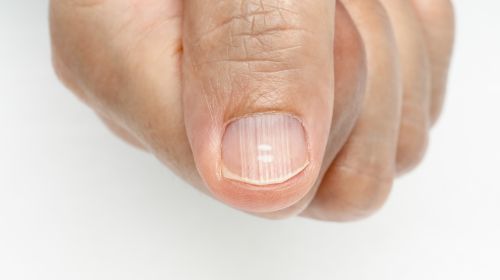Every second patient with nail fungus does not recognize the disease as such or ignores the symptoms. Early therapy is very important for the success of the treatment. Signs such as discoloration can indicate an early stage of fungal infection. If the disease progresses, it manifests itself through symptoms such as thickening, deformation and detachment of the nail plate.
- Check your feet regularly to detect symptoms of nail fungus early on.
- © Getty Images / iStock.com / Vadymvdrobot
Nail fungus (onychomycosis) is caused by an infection with filamentous fungi (dermatophytes). The disease not only affects the nails, it can also extend to other parts of the body. In addition, fellow human beings, especially family members, can become infected.
Take symptoms of nail fungus seriously
If you suspect that you have a nail fungus disease on the toenails or fingernails, you should definitely go to the dermatologist. Because Without effective treatment, the infection will sooner or later destroy the entire nail,
The treatment of a nail fungus infection should start early, not only for cosmetic reasons: the nails offer important protection, for example against the pressure of the shoes. Without nails, this can easily lead to painful pressure sores on the toes. The destruction of the nails by onychomycosis is easy to avoid – if the early signs are taken seriously.
First symptom: nails become dull
Since the complaints are often not very pronounced, the first signs become a nail fungus infection, however often overlooked, The disease can be seen well before the nail dissolves. The following changes occur during the infection with the fungal pathogens:
unglossiness: First, once healthy nails lose their pearlescent sheen, they become dull and cloudy.
discoloration: Due to the fungal attack, the nails change color so that the nail bed no longer shimmers pink. The color can white, yellow, green or brown his.
thickening: The nail plate gradually thickens, which affects the nail substance.
replacement: Later the nail plate lifts off the nail bed. This creates a gap.
nail decay: If the fungus remains untreated, the individual nail layers crumble. In the end, the nail substance is completely destroyed
Even if the nail fungus is still in the first stage, a visit to the dermatologist is advisable: the sooner the toenail fungus or fingernail fungus is treated, the better the prospect of rapid healing. In addition, the doctor can check whether the symptoms are actually a fungal pathogen, another nail disease or a harmless change in the nails.
Symptoms of different types of nail fungus
There are several types of nail fungus, which are differentiated according to the infected area of the nail:
- distal subungual onychomycosis
- proximal subungual onychomycosis
- total dystrophic onychomycosis
- white superficial onychomycosis
The most common manifestation a nail fungus infection is the distal subungual onychomycosis, In this type of infestation, the fungal spores spread from the tip of the finger or toe, below the nail plate. The fungal pathogens first settle on the edge of the nail in the gap below the nail plate and from there penetrate into the nail area. The disease gradually spreads in the border area between the nail plate and the nail bed in the direction of the metacarpus. The affected part of the nail plate usually becomes opaque and turns white, yellowish or brownish depending on the fungal pathogen. Under certain circumstances, the part of the nail plate that is infiltrated by the fungus can also thicken and / or become brittle.
In the proximal subungual onychomycosis the fungus spreads below the nail plate – not from the free edge of the nail, but from the direction of the nail root.
In the total dystrophic onychomycosis the nail root is affected. It can develop from pre-existing distal subungual onychomycosis by spreading the fungus. The involvement of the nail root leads to a disruption of the nail growth with the formation of a yellow to brownish discolored, friable and thickened nail plate.
In the white superficial onychomycosis the growth of the fungus on the surface of the nail plate leads to a very superficial white discoloration without changing the nail structure.
Treat nail fungus properly
Lifeline / Wochit
Do not ignore athlete's foot symptoms!
It is not uncommon for a toenail fungus to develop from an athlete's foot infection, so you should pay attention to the corresponding symptoms. In about 80 percent of cases Infection between the toes to find where symptoms of athlete's foot become visible. The sole and back of the foot or the edges of the feet are affected much less frequently. This is not surprising, because the fungal spores feel particularly comfortable in the moist milieu between the toes.
The first sign of a fungal disease of the feet is usually itching, particularly often between the fourth and fifth toe. In addition, the skin is often reddish or whitish in color, and blisters or cracks can form. The skin flakes, burns or hurts. In later stages, the skin can look like "cooked meat".
-

How to properly care for your feet and hands to prevent nail fungus and what you should consider when doing manicures and pedicures if you are already infected
read more!
What does a healthy fingernail look like?
A healthy fingernail is firm yet flexible, has an even surface that is slightly curved, and is about 0.5 millimeters thick. A normal nail is matt-transparent, but above the well-perfused nail bed it looks delicate pink.
Notches, grooves, white spots are harmless
Many have white spots in the nail area. This does not look nice, but is no cause for concern: these are harmless air pockets that arise as a result of minor injuries, for example due to an impact or if the cuticle is pushed too gently backwards during the manicure. In addition to the cloud-shaped spots, there are also notches in the horn plate – mostly the result of mechanical force – or fine, flat longitudinal grooves, which almost everyone can find on their fingernails. They are usually signs of a normal aging process and become stronger over the years. Some of them are also inherited.
Other nail diseases: eczema, nail bed infection, bacterial infection
However, other nail changes can be signs of a disease or physical disorder. The most common disease-related changes that appear on the nails include nail fungus diseases and psoriasis, They have very similar signs.
Nail eczema due to irritation from cleaning agents, for example, can be recognized by reddened scaly fingernail walls or a rough nail surface. Inflammation of the nail bed, for example, is noticeable through reddening, warming and sometimes pus formation. Sometimes infections also cause the nails to change color: if the pathogens are Pseudomonas bacteria, they turn greenish, for example.
Have your dermatologist examine nail changes
The nails could also reflect deficiency symptoms of the entire organism. If the body lacks biotin, for example, this often manifests itself in brittle, brittle nails or growth disorders. And if there is a pronounced iron deficiency, so-called spoon nails sometimes form: These are fingernails, the plate of which has sunk in the middle and which, in addition to the lack of iron, can indicate anemia, among other things. Nail plates that bulge outward like a watch glass can be a concomitant symptom of a heart or lung disease.
Those affected should always investigate such suspicions. Spot dark spots under the nail are also examined. Often it is just a bruise – in the worst case, black skin cancer can also be behind it.


